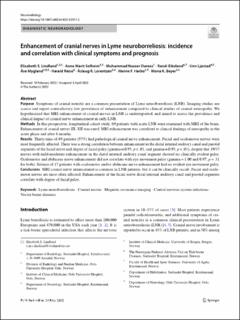| dc.contributor.author | Lindland, Elisabeth S. | |
| dc.contributor.author | Solheim, Anne Marit | |
| dc.contributor.author | Dareez, Muhammad Nazeer | |
| dc.contributor.author | Eikeland, Randi | |
| dc.contributor.author | Ljøstad, Unn | |
| dc.contributor.author | Mygland, Åse | |
| dc.contributor.author | Reiso, Harald | |
| dc.contributor.author | Lorentzen, Åslaug R. | |
| dc.contributor.author | Harbo, Hanne F. | |
| dc.contributor.author | Beyer, Mona K. | |
| dc.date.accessioned | 2023-01-11T08:49:37Z | |
| dc.date.available | 2023-01-11T08:49:37Z | |
| dc.date.created | 2022-06-30T13:59:59Z | |
| dc.date.issued | 2022 | |
| dc.identifier.citation | Lindland, E. S., Solheim, A. M., Dareez, M. N., Eikeland, R., Ljøstad, U., Mygland, Å., Reiso, H., Lorentzen, Å. R., Harbo, H. F. & Beyer, M. K. (2022). Enhancement of cranial nerves in Lyme neuroborreliosis: incidence and correlation with clinical symptoms and prognosis. Neuroradiology, 64, 2323-2333. | en_US |
| dc.identifier.issn | 1432-1920 | |
| dc.identifier.uri | https://hdl.handle.net/11250/3042565 | |
| dc.description.abstract | Purpose Symptoms of cranial neuritis are a common presentation of Lyme neuroborreliosis (LNB). Imaging studies are scarce and report contradictory low prevalence of enhancement compared to clinical studies of cranial neuropathy. We hypothesized that MRI enhancement of cranial nerves in LNB is underreported, and aimed to assess the prevalence and clinical impact of cranial nerve enhancement in early LNB. Methods In this prospective, longitudinal cohort study, 69 patients with acute LNB were examined with MRI of the brain. Enhancement of cranial nerves III–XII was rated. MRI enhancement was correlated to clinical fndings of neuropathy in the acute phase and after 6 months. Results Thirty-nine of 69 patients (57%) had pathological cranial nerve enhancement. Facial and oculomotor nerves were most frequently afected. There was a strong correlation between enhancement in the distal internal auditory canal and parotid segments of the facial nerve and degree of facial palsy (gamma=0.95, p<.01, and gamma=0.93, p<.01), despite that 19/37 nerves with mild-moderate enhancement in the distal internal auditory canal segment showed no clinically evident palsy. Oculomotor and abducens nerve enhancement did not correlate with eye movement palsy (gamma=1.00 and 0.97, p=.31 for both). Sixteen of 17 patients with oculomotor and/or abducens nerve enhancement had no evident eye movement palsy. Conclusions MRI cranial nerve enhancement is common in LNB patients, but it can be clinically occult. Facial and oculomotor nerves are most often afected. Enhancement of the facial nerve distal internal auditory canal and parotid segments correlate with degree of facial palsy. | en_US |
| dc.language.iso | eng | en_US |
| dc.publisher | Springer | en_US |
| dc.rights | Navngivelse 4.0 Internasjonal | * |
| dc.rights.uri | http://creativecommons.org/licenses/by/4.0/deed.no | * |
| dc.title | Enhancement of cranial nerves in Lyme neuroborreliosis: incidence and correlation with clinical symptoms and prognosis | en_US |
| dc.type | Peer reviewed | en_US |
| dc.type | Journal article | en_US |
| dc.description.version | publishedVersion | en_US |
| dc.rights.holder | © 2022 The Author(s) | en_US |
| dc.subject.nsi | VDP::Medisinske Fag: 700::Klinisk medisinske fag: 750::Nevrologi: 752 | en_US |
| dc.source.pagenumber | 2323–2333 | en_US |
| dc.source.volume | 64 | en_US |
| dc.source.journal | Neuroradiology | en_US |
| dc.identifier.doi | https://doi.org/10.1007/s00234-022-02957-2 | |
| dc.identifier.cristin | 2036385 | |
| cristin.qualitycode | 1 | |

